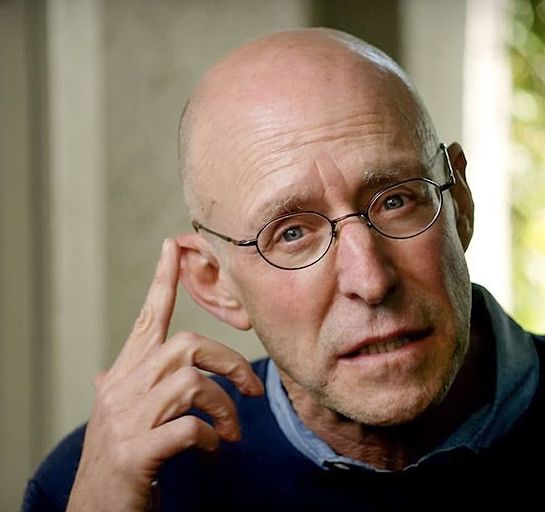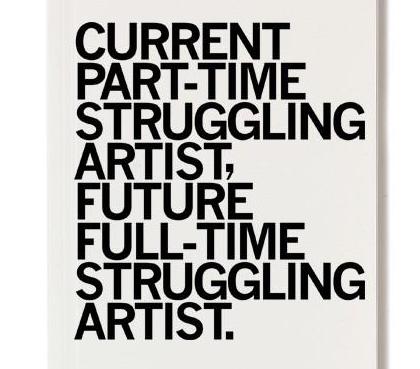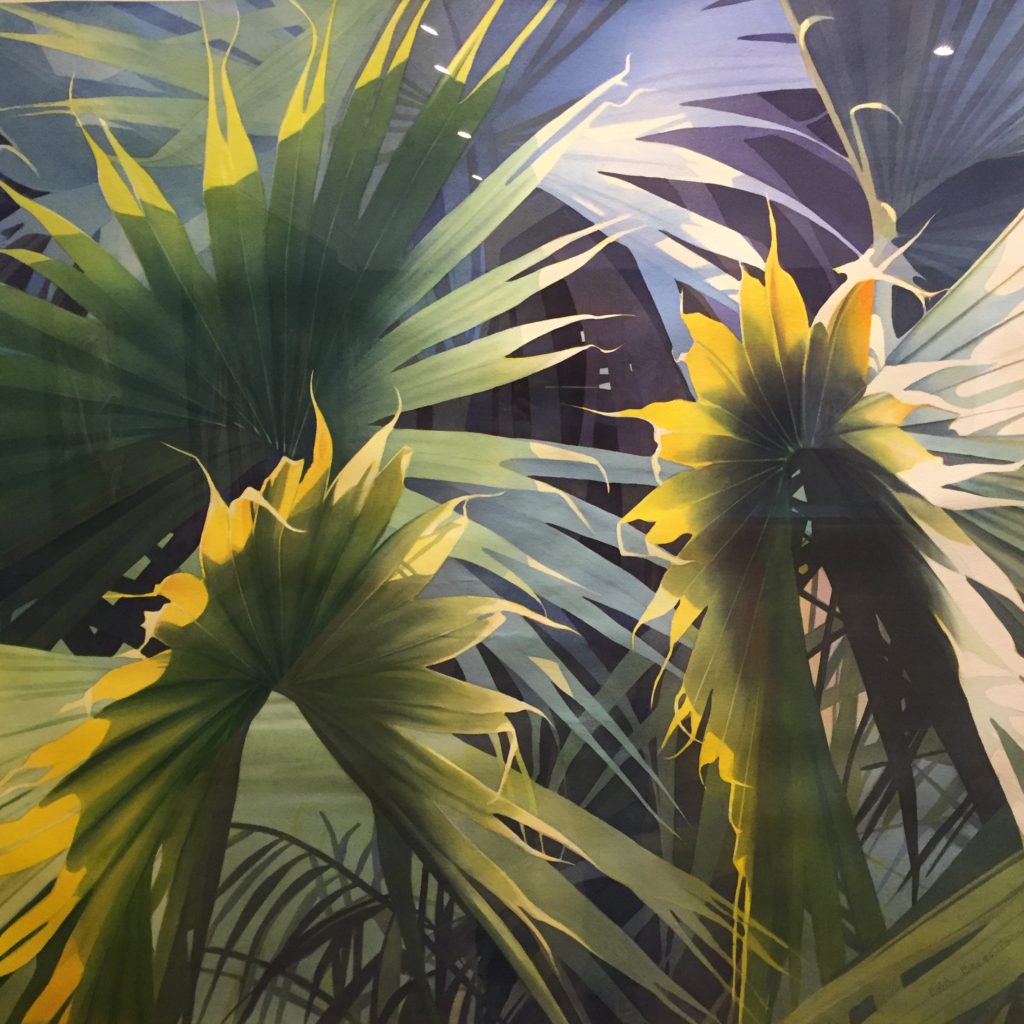June 26th, 2018 by dave dorsey

Michael Pollan (source:YouTube)
I’m reading Michael Pollan’s How to Change Your Mind, which describes the wave of new research into psychedelic drugs. It’s in the same vein as Aldous Huxley’s The Doors of Perception, drawing parallels between what users experience and what mystics from various religious traditions said about their own encounters with transcendence. I’ve never experimented with these substances, despite pressure to do it from the other members of my garage band in high school, in which I played guitar. (They all had a habit of dropping mescaline before practice sessions.) I have no interest in trying them now. What’s compelling about Pollan’s book is that he had little interest in religion and spirituality when he began his research and was surprised by what he discovered as he got deeper into the subject. What interests me in all this is how it relates to the way in which the process of painting is a much quieter, and less dramatic, path toward a similar sort of ego-effacing state of awareness–though that phrase would hardly describe much of the higher profile art being produced now. (Critics, of course, can make the discipline even more ego-effacing . . . )
“The study demonstrated that a high dose of psilocybin could be used to safely and reliably “occasion” a mystical experience—typically described as the dissolution of one’s ego followed by a sense of merging with nature or the universe. This might not come as news to people who take psychedelic drugs or to the researchers who first studied them back in the 1950s and 1960s. But it wasn’t at all obvious to modern science, or to me, in 2006, when the paper was published. What was most remarkable about the results reported in the article is that participants ranked their psilocybin experience as one of the most meaningful in their lives, comparable “to the birth of a first child or death of a parent.”
“AS SOMEONE not at all sure he has ever had a single “spiritually significant” experience, much less enough of them to make a ranking, I found that the 2006 paper piqued my curiosity but also my skepticism. Many of the volunteers described being given access to an alternative reality, a “beyond” where the usual physical laws don’t apply and various manifestations of cosmic consciousness or divinity present themselves as unmistakably real. All this I found both a little hard to take (couldn’t this be just a drug-induced hallucination?) and yet at the same time intriguing; part of me wanted it to be true, whatever exactly “it” was. This surprised me, because I have never thought of myself as a particularly spiritual, much less mystical, person. This is partly a function of worldview, I suppose, and partly of neglect: I’ve never devoted much time to exploring spiritual paths and did not have a religious upbringing.”
“The story of how this paper came to be sheds an interesting light on the fraught relationship between science and that other realm of human inquiry that science has historically disdained and generally wants nothing to do with: spirituality. For in designing this, the first modern study of psilocybin, Griffiths had decided to focus not on a potential therapeutic application of the drug—the path taken by other researchers hoping to rehabilitate other banned substances, like MDMA—but rather on the spiritual effects of the experience on so-called healthy normals. What good was that? In an editorial accompanying Griffiths’s paper, the University of Chicago psychiatrist and drug abuse expert Harriet de Wit tried to address this tension, pointing out that the quest for experiences that “free oneself of the bounds of everyday perception and thought in a search for universal truths and enlightenment” is an abiding element of our humanity that has nevertheless “enjoyed little credibility in the mainstream scientific world.” The time had come, she suggested, for science “to recognize these extraordinary subjective experiences . . . even if they sometimes involve claims about ultimate realities that lie outside the purview of science.”
By the time Griffiths turned fifty, in 1994, he was a scientist at the top of his game and his field. But that year Griffiths’s career took an unexpected turn, the result of two serendipitous introductions. The first came when a friend introduced him to Siddha Yoga. Despite his behaviorist orientation as a scientist, Griffiths had always been interested in what philosophers call phenomenology—the subjective experience of consciousness. He had tried meditation as a graduate student but found that “he couldn’t sit still without going stark-raving mad. Three minutes felt like three hours.” But when he tried it again in 1994, “something opened up for me.” He started meditating regularly, going on retreats, and working his way through a variety of Eastern spiritual traditions. He found himself drawn “deeper and deeper into this mystery.” Somewhere along the way, Griffiths had what he modestly describes as “a funny kind of awakening”—a mystical experience. I was surprised when Griffiths mentioned this during our first meeting in his office, so I hadn’t followed up, but even after I had gotten to know him a little better, Griffiths was still reluctant to say much more about exactly what happened and, as someone who had never had such an experience, I had trouble gaining any traction with the idea whatsoever. All he would tell me is that the experience, which took place in his meditation practice, acquainted him with “something way, way beyond a material worldview that I can’t really talk to my colleagues about, because it involves metaphors or assumptions that I’m really uncomfortable with as a scientist.” In time, what he was learning about “the mystery of consciousness and existence” in his meditation practice came to seem more compelling to him than his science. He began to feel somewhat alienated: “None of the people I was close to had any interest in entertaining those questions, which fell into the general category of the spiritual, and religious people I just didn’t get.”
Later, he quotes another researcher:
“You go deep enough or far out enough in consciousness, you will bump into the sacred. It’s not something we generate; it’s something out there waiting to be discovered. And this reliably happens to nonbelievers as well as believers.” Whether occasioned by drugs or other means, these experiences of mystical consciousness are in all likelihood the primal basis of religion.
June 21st, 2018 by dave dorsey

About a week ago, Hyperallergic published a great, brief assessment of how tough it is to make a living as an artist, and it’s pretty obvious that if you want a life of luxury then you should look into investment banking. Yet the ultimate effect of the piece is heartening. Most of us are on the same life raft. On the whole, artists don’t make much. But we find ways to make ends meet and still make art. And the longer we stick with it, the happier we get. The writer, Benjamin Sutton, was reporting on a study released by Creative Independent, an offshoot of Kickstarter. The group surveyed artists in the U.S., UK, Canada, France and roughly 50 other countries.
What’s most welcome about the piece is how it actually showed that it’s possible to be serious–and reasonably happy–about making art without being able to stay solvent from the proceeds. Which means, more or less, that if you think Van Gogh was a failure, then you need at attitude readjustment, friend. Failure isn’t about money when it comes to creative endeavors.
Here were some of the finding:
- The majority of visual artists working today make less than $30,000 per year. (Average median income in the U.S. is nearly double that.)
- Only 12% of respondents said that gallery sales of their work have been helpful in sustaining their practices, and grants ranked similarly low.
- Two thirds said they had to rely on freelance work to make a living. The next largest segment do work unrelated to art for the bulk of their income.
- Half of all artists surveyed said they make less than 10 percent of their income from their art.
- Schools don’t prepare artists for a world that runs on the exchange of money–though it’s hard to see from the findings what art schools could actually do to help artists earn more. A little more preparation for how one needs to find other ways to make a living in addition to art maybe . . .
- Just under a third of respondents felt that gallery representation did little to improve their financial stability. The gatekeepers are finding it just as difficult to stay in the black as the artists themselves.
- The Malcolm Gladwell rule of 10,000 hours of practice as a threshold for mastery–in this case ten years of work–makes a difference. Artists who stick to a professional regimen for a decade earn more and find themselves much happier with the life of making art. After two decades, happiness rises even more.
June 10th, 2018 by dave dorsey

Palm Pattern #125, Edith Bergstrom, at Butler Institute of American Art
The Butler Institute of American Art, the nation’s first museum devoted exclusively to American art, is a jewel tucked way in an old, slimmed-down Rust Belt town, which was booming when America’s industrial age was in full swing. Youngstown is probably one of the communities hardest hit by the migration of heavy industry out of the U.S. and has had to rebuild since huge job losses in the 1970s. Once a city of 170,000 people, it shrank to around a third of that in the 70s and 80s. As with most cities once nourished by the Erie Canal (like the one in which I live), it has had to find ways to diversify its economy and attract and grow innovative new technology firms despite the Great Lakes climate. In the past decade, Youngstown began to stir with new economic life and because of its history as an industrial powerhouse, back when it attracted immigrant workers from around the world, it remains one of the most racially and culturally diverse cities in the nation. Flint and Detroit may get all the publicity, but Youngstown has to have been buffeted and betrayed by the global economy about as severely as any town in the world—and yet it has found a path forward to a new sort of identity and pride in itself. The Butler seems to assert a kind of unassailable character, an affirmation that a few quiet human virtues—gratitude, appreciation, taste—won’t just survive but can prevail in our current feverish media culture. It feels a little miraculous to walk into this little oasis of beauty and wisdom hidden in “flyover country,” among the ghosts of steel mills almost exactly halfway between New York City and Chicago, in the foothills of the Appalachian Mountains.
I delivered a painting to the Butler this past week for the Midyear exhibition by driving west through Buffalo and Erie. I was startled, when I turned onto Wick Avenue, where the museum is situated on the Youngstown State University campus. It’s a beautiful structure, a little grander in person than in its photographs, with a columned façade that looks as if it were modeled after one of Piero’s early Renaissance piazzas. After I dropped off my still life in its wooden crate, I decided to linger for a look at my destination. It was such a pleasure, I ended up staying far longer than I’d intended. It was like being introduced to someone with whom you feel a deep affinity—both the permanent collection and the current temporary exhibits were evidence of a guiding, deeply affectionate intelligence about great art. That sense of welcoming affinity is how I feel every time I visit the Phillips Collection, and to a slightly lesser degree, smaller museums like the Morgan and the Frick—as if I’m perfectly at home in the space and with the work itself. Many of the museums in cities that once thrived because of the Erie Canal offer art museums whose character is akin to the Butler’s—The Albright-Knox, the Memorial Art Gallery, The Everson and Munson-Williams Proctor. The emphasis on American Art at Butler makes it somehow feel the most companionable of them all. By contrast, this hospitable sense of belonging is what I don’t feel when I tour many galleries and some museums. The Tate Modern in London, for example, had an atmosphere of severity, an almost impersonal sense that the art on display was meant to be a rude awakening, which is fine. That’s certainly a recurrent quality in modernist and post-modern work, and there’s nothing wrong with the occasional swift kick to the head, but here, everything I saw seemed to be imbued with a sense that art can celebrate life as a welcome gift. It was moving to feel this kind of serenity in a community that has endured enormous tribulations as America’s economy reconfigures itself.
It was a pleasure that a few of the paintings I was seeing for the first time had been familiar to me from reproductions for decades–while others were unfamiliar works by some of my favorite artists. It was a delight to finally see, in person, Edward Hopper’s Pennsylvania Coal Town, James Valerio’s Ruth and Cecil Him, and Music by John Koch along the mezzanine in the museum’s central gallery. Each is an example of the painter’s mastery at its peak. They were on display along with equally powerful work by Janet Fish, Neil Welliver, Alfred Leslie, Will Barnett, Jules Olitski, Paul Jenkins, Motherwell, Avery, Gorky, Ivan Albright and Pollock. Much of the work is exceptionally good, sometimes MORE


